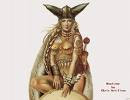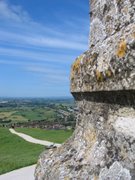Magic Folklore Myths in my Celtic Blood
I booked a tour called Celtic Experience – woke up early and walked up to Suffolk Street where an old converted church holds a large collection of souvenirs, tour bookings and information booths. Yesterday while walking around Dublin I noticed the traffic jams and this morning it was obviously slower. It must be said that Dublin traffic would be the worst I have ever seen. The city is growing and renovating and reconstructing. Where it is usual for one or two traffic lanes, many are closed due to building site danger. It is far quicker to walk than it is to take a bus, Lurs or Taxi. Consistently buses are late and the locals laugh at you when you mention that a tour bus is late. “What did you expect – this is Dublin.” He he he
So eventually our tiny little mini van tour bus arrived with the driver all in a flurry. There were 10 of us and we eventually got out of Dublin and onto the northern freeway system. Our driver was our guide and in lilting Gaelic tone he told stories of Tuathta De Danaan, Fir Bolg, the Celts and the various faery tales and mythologies of Ireland. He was a brilliant storyteller with a great love for the history of his country.
First stop was Fourknocks megalithic mound, Naul in County Meath. The name Fourknocks comes from the Irish 'Fuair Cnocs' which means 'The Cold Hills' and my hands were literally turning blue as we stood outside the mound while our guide told us the story. The mound is part of a complex of small sites in the area, and forms part of the Art of Alignment, so common here in this country. This mound is directly aligned with the line of Winter Solstice sunrise through the holes in the top of the mound lighting up inside at specific stellar times. We crouched down and walked into this enormous underground chamber. There are zigzag patterns on a number of stones inside and scholars believe this refers to the constellation, Cassiopeia, which would have been visible through the Fourknocks passage between 3000BC and 2500BC, around the time the site was constructed. The symbols used here are all about astronomy – creating calendars based on shapes for sun, moon, stars – constellations.
The way that this mound was designed it is obvious that is was to capture a specific moment in astronomical time. There is no doubt that the people of the Neolithic were acutely aware of the great cycle of precession.
It was freezing at Fourknocks and by the time we all loaded back onto the small bus, there were icicles on some people’s boots and jackets. Gorgeous setting regardless of the cold, rolling misty green hills surrounded us linked by old roads cutting through small villages and tiny cottages. In the middle of nowhere we stumbled across this significant site and coupled with the story telling, it was quite a magical experience.
Our bus then took us to Monasterboice - St Buithe's Abbey, an early monastic site celebrated for its crosses, near the Irish east coast, northwest of Drogheda. Alighting from the bus we were greeted by a horrible stench. Apparently this is soilage – a combination of manure and soil used to maintain the green rolling hills. At least it kept my nose distracted while the rest of me froze as we walked down a lane lined with winter bared trees until we came across a graveyard featuring the largest Celtic Crosses I have ever seen.
Our guide explained how these crosses are like complete museums as they contain narrative scenes about various biblical stories in decorative abstract motifs. When the Romans arrived, they needed to market themselves to the Celts and this was an initial effective strategy. Most early medieval monasteries in this area feature freestanding, monumental crosses some up to 17 feet in height. The decorations – now covered in moss are incredible abstract ornamental patterns (the Celtic interlace and spirals, geometric patterns, inhabited vines, and entangled figures) combined with naïve Christian figures as their main story telling device. It was raining as our guide deciphered one of these large crosses and once again it felt magical and as if we were transported back in time to a live and very real mythology.
We drove through tiny back roads while listening to the best of Irish music. I have probably heard “Cockles and Muscles” approx 100 times in this past week. J U2, Sinnead O’Connor and some truly interesting new irish musicians – watching the irish countryside roll by the bus window while accompanied by the irish music captured the heart of this experience really well.
Next stop was at Mellifont Abbey - a ruin now – and was the first Cistercian Abbey to be founded in Ireland. It is located between the village of Collon and the town of Drogheda in County Louth. We drove into an impressive tranquil valley near the Mattock River lined with leaf less trees and the now familiar greenest of green hills – and yup still sporting that stink.Seriously there’s nothing to see here except ruins and maps and charts of what it USED to look like. Still combined with our guide story telling, we could almost visualise the Abbey in all its glory.
By this time we were not only frozen to the core but starving so we were taken to a local pub in Collon in the south west corner of County Louth. Here I met several other aussies, naturally and a guy from Boston who works in mental health – always a fun discussion topic and we embarked on a heated discussion about the 2008 US Presidential elections. The concensus is very Clinton. I will continue to send my wishes to Obama – the world could do with a leader like him.
After a hot roast meal, fortified with a Guinness or two, it was time to head towards our next destination, the hill of Slane.This is sold as a major christian site where St Patrick lit some fire os significance and began the destruction of the Celtic and Gaelic cultural heritage. This site where there is a mound on the western end of the peak, which lies hidden from the view of visitors by lots of trees, has a very ancient significance. The Fir Bolg King, Sláine, who gives his name to the area was associated with this mound and quite possibly buried here. The people of this land loved a fight – seriously – there’s always a tale in this land of someone battling someone else and. This is all part of tradition and legend in this country. Standing high on this mound looking out over the hills towards the ocean and the Hill of Tara and the surrounding countryside, I could almost feel the other worlds and the histories all happening simultaneously.
There is profound energy here on this ancient Neolithic site. I read this passage from 'Táin Bó Cualgne' : '' . . . MacRoth surveyed the plain and he saw something: a heavy, grey mist that filled the space between the heavens and earth. It seemed to him that the hills were islands in lakes that he saw rising up out of the sloping valleys of mist. It seemed to him they were wide-yawning caverns that he saw there leading into that mist. It seemed to him it was all-white, flaxy sheets of linen, or sifted snow a-falling that he was there through a rift in the mist. It seemed to him it was a flight of many, varied, wonderful, numerous birds, or the constant sparkling of shining stars on a bright, clear night of hoar-frost, or sparks of red-flaming fire. . .'' I could almost see everything noted in those words.
The thing I really loved about today was learning more about the Art of Alignment. This mound in Slane forms a very interesting alignment with some other ancient sites. There is a 360-degree view and you can see the four corners of Ireland and most importantly directly to the Hill of Tara. Everything was created for astronomical purposes. The first bard of Ireland was called Amergin and his very famous saying rings true here at the Hill of Slane. ''What land is better than this island of the setting sun; who but I can tell the ages of the moon.''
Our small group was significantly quieter and awestruck we our bus drove off towards Tara. It was almost a religious experience in many ways when you realised how everything was aligned and designed over five thousand years ago.
Light was fading, after all it WAS 3pm as we drove up to Teamhair na Rí, "Hill of the King" – the hill of Tara. It is a long, low limestone ridge that runs between Navan and Dunshaughlin in Meath. According to tradition, this is the big site - the seat of Árd Rí na hÉireann, The High King. And it was bloody cold – the coldest all day in fact!
We were greeted by signs re telling what USED to be here and of course hundreds of black and white sheep who viewed us with disdain – bloody tourists again!
Once again this hilltop has witnesses countless significant battles and dates back past 3000BC. Very Iron Age! The centrepiece here once we climbed up and over mounds and across ring barrows was the Stone of Destiny. Now this is beginning to sound like a Jack Black movie but it was very cool. Here in the middle of the Forradh stood a medium height stone standing, at which the High Kings were crowned. According to legend, the stone would scream if a future king touched it. We all took turns and not one murmur. I’m not sure I could squeeze anything else into my work life so probably better this way.
Standing on this mound you look directly over at the Hill of Slane across a ringfort with three banks. The Hill of Tara is all about the seat of the kings of Ireland until the 6th century. However the significance of the Hill of Tara predates Celtic times, typically the Neolithic when people were quite busy it seems here.
I walked past the mound of the Hostages, which has a short passage which is aligned with sunset on the days of the ancient Celtic festivals of Samhain and Imbolc as well as being in the exact direction for the Winter Solstice. Obviously these people held deep knowledge of astronomical movements. Legend names the Hill of Tara as the capital of the Tuatha De Danaan, pre-Celtic dwellers of Ireland. It was here on this mound where I surely felt a sturring of the celtic blood in my veins.
Driving home in the cold wet dark Irish afternoon we soon encountered that now famous Dublin traffic and eventually disembarked at the boardwalk on the river Liffey to walk the remainder of the journey. It took an hour to reach the Raddison and what a great way to further explore this city. The guide noted that the Dublin traffic is worsening by the day and that he has not been able to deliver people back to the starting point for at least 12 months now.
I doubt I will complain about Milton Road traffic ever again. (Ok give me one week!)

